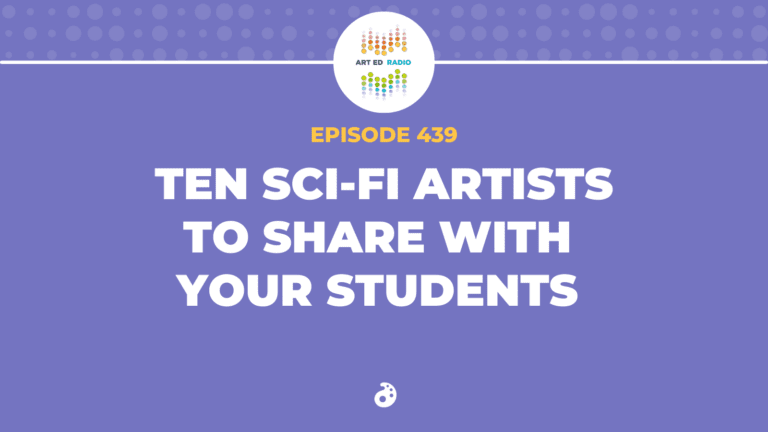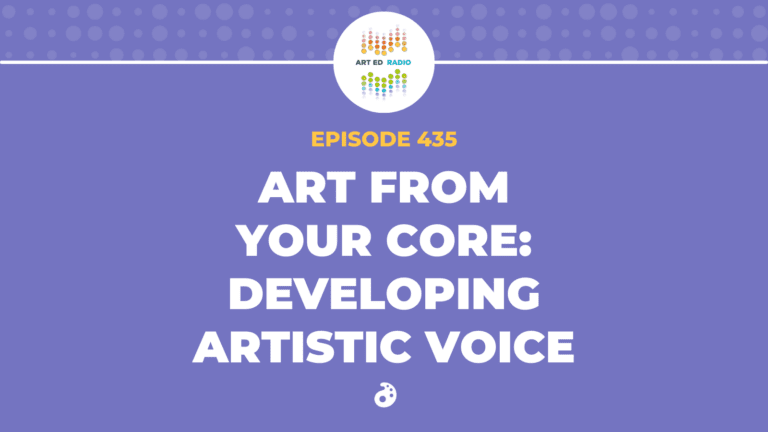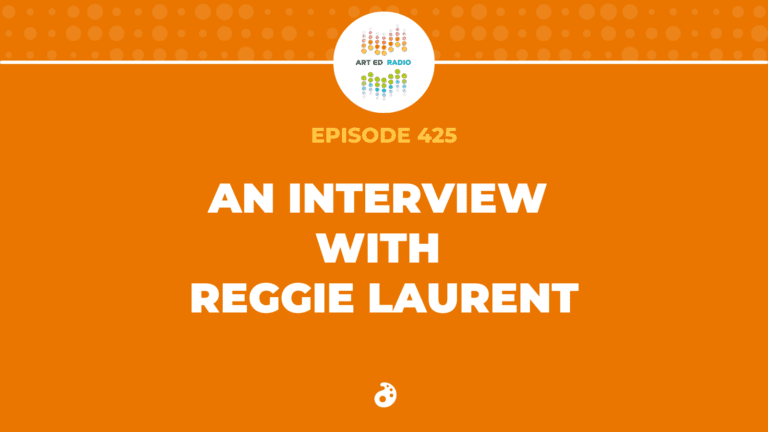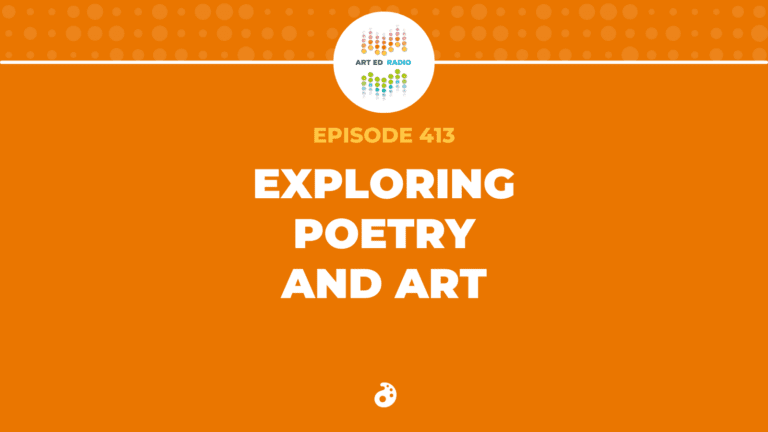Following last week’s discussion on engagement strategies, Tim is back to share a unique way to get kids excited about art—Arts Madness! Kyle Wood comes on the episode to talk about how he is gamifying his classroom, how Arts Madness gets kids involved and thinking critically about art history, and why teachers at every level should participate in the event. Full Episode Transcript Below.
Resources and Links
- View the Arts Madness bracket
- Check out the Who Arted? podcast
- Listen to Tim’s episode with Kyle about Christo and Jeanne-Claude
- Find Kyle on Twitter
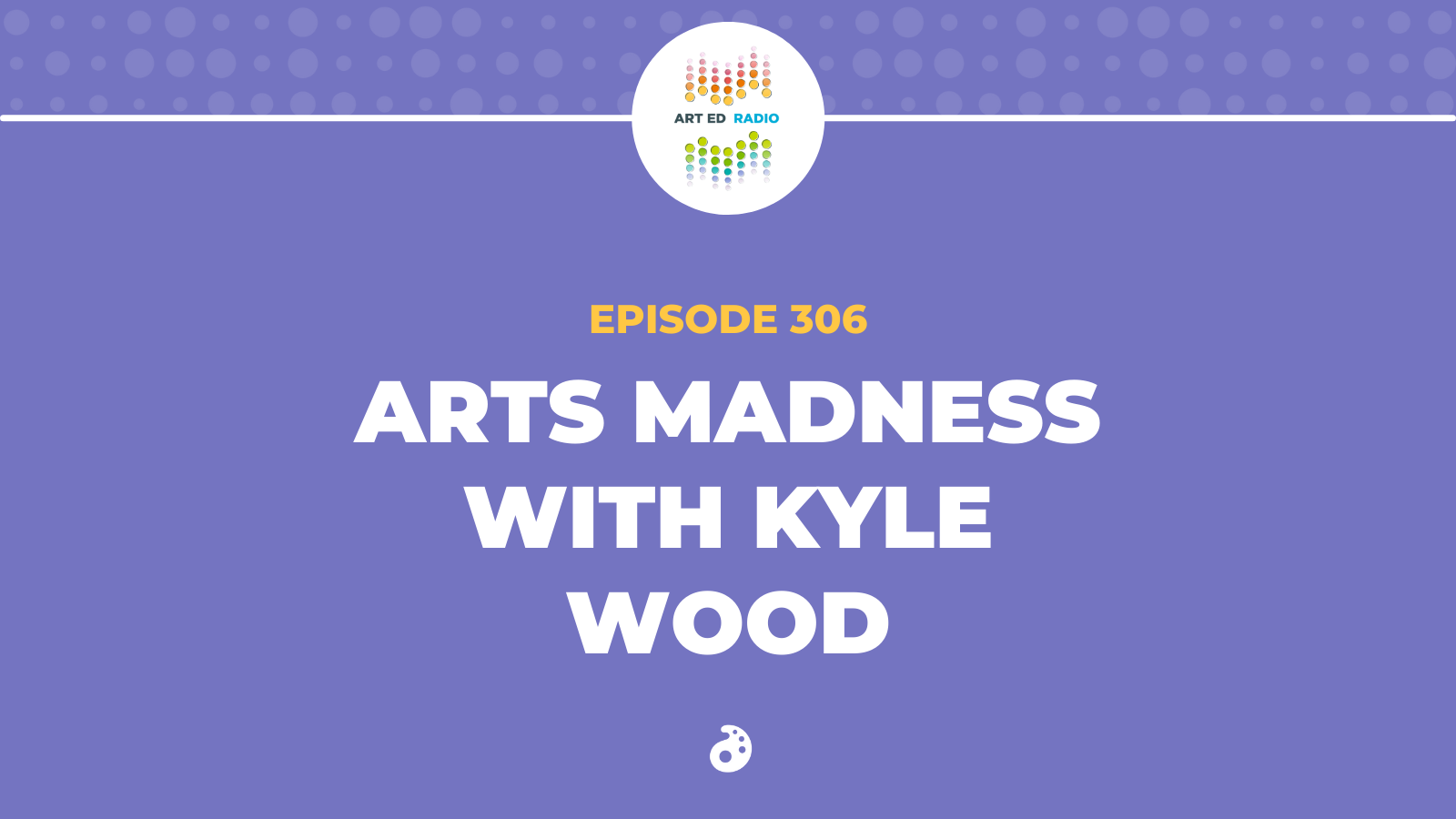
Transcript
Tim: Welcome to Art Ed Radio, the podcast for art teachers. This show is produced by The Art of Education University. And I’m your host, Tim Bogatz.
Welcome to the first day of March. Now, March brings with it a lot of things, nicer weather, hopefully coming sooner rather than later, spring break for most of us, hopefully in a couple of weeks, the NAEA National Convention, which is later this week, believe it or not. And for some sports fans like me, the March Madness college basketball tournament. And while that’s going on for a lot of us in the art room, it opens up the option to do our own sort of version, our own art version of March Madness and my guest today is doing that better than just about anyone. His name is Kyle Wood and he’s the host of the Who ARTed podcast, as well as an elementary art teacher. Every year, he hosts the Arts Madness Tournament. Notice we said Arts Madness. He does that online. He invites teachers everywhere to be part of it. He posts the brackets, the match-ups, and has just thousands of students across the country voting.
And the vote is determined by the simple question, which is better? And it’s up to the voter to decide the criteria for determining which artist or which work is better. It’s a great opportunity to bring in some art history, some discussion and debate and some critical thinking into your classroom and do it in a really, really fun way. I want to talk to Kyle about the tournament, but also about his podcast and some of the cool things that he has happening in his classroom, so here he is.
All right, Kyle Wood is joining me now. Kyle, how are you?
Kyle: I am doing well. I am really happy to be here. I’ve been listening for a long time and it’s a surreal experience to get to talk to somebody that I have listened to and now have a dialogue, so thank you very much for having me.
Tim: Yeah, I appreciate the kind words. And for those people that don’t know, we’re doing a home and home podcast here where I’m going to be on Who ARTed talking about Christo and Jeanne-Claude and you’re going to be here talking about all sorts of cool things you do in your classroom, plus Who ARTed, plus March Madness, and just a lot of cool things going on. But before we dive into all of that, can you just give us an introduction? Tell us a little bit about yourself, maybe about where you teach, what you do outside of school?
Kyle: Yeah. I am K-5 art since 2007, so… man, going on like what, 15 years?
Tim: Yeah.
Kyle: I am outside of the Chicago area, the suburb of Chicago, so I got my BFA from SAIC, started teaching right away, right after that. And did the kind of standard after a few years earn the masters, got my national boards, all that. And really outside of school, like I have my own kids, I have small kids. That’s my hobbies outside of school.
Tim: It’s amazing how those kids become your hobby, like you really don’t have much of a choice.
Kyle: But before I was an okay artist, I was a terrible musician and I still love music and playing with the sound equipment and stuff like that, so in the little bits of spare time that I get after the kids are in bed, I do come down to my basement bunker studio. And I like to either play my guitar a little bit, or I do some podcasts and stuff like that. It’s becoming a bit of a family business as my son is also getting into podcasting now too.
Tim: Oh, Fantastic. Yeah. My 14-year-old, my daughter, she had her own podcast during the pandemic and I got to say it was pretty good. She just stole all my equipment and recorded, it sounded good of course. And I thought it was interesting, but she’s too busy now, so no more, but it’s always fun to see your kids. I don’t know. I’m just always happy when they’re creating rather than just consuming.
Kyle: Oh, absolutely. Yeah. I’m very much the same. I’m the type who’s always trying to push my kids to just be doing something active and creative.
Tim: Yeah.
Kyle: And it’s been fun, I’ve been doing my podcast and he was like, can we do one together? And so that was my way of getting him to do a little bit more reading and research.
Tim: Oh yeah. That’s awesome.
Kyle: Yeah.
Tim: Yeah. Good for him. Cool. Hey, tell me about your classroom, like we should probably talk art teaching a little bit.
Kyle: Probably should.
Tim: What is your teaching style like? What’s a typical day like? What would we see if we drop in on your classroom?
Kyle: I am prone to going off on tangents if that wasn’t already obvious. My classrooms, it’s probably a little bit different from most elementary art rooms for better or worse. It’s somewhat choice based. Although, I do want to be clear, I’m not like strictly a tab guy. I’m not strictly an anything kind of guy, but like I do this gamification with my classroom. I think of it sort of as gamified choice, each kid has their own slide deck, I use Google slides to organize everything. And essentially that is their menu of options for different projects and skills to focus on. And so I’ve got like around the room, 25 different kids doing 25 different projects. And after they complete a project, once they’ve hit the learning targets that are listed on the slide, they photograph their work, they put it into their little digital portfolio, they get a digital badge. And then after a certain number of badges, they level up and unlock new options, which basically means I copy and paste some other slides into their slide deck.
Tim: That works though.
Kyle: Yeah.
Tim: I was just going to say like that reminds me of my advanced classes where like every kid’s working on something different. I’m kind of interested to hear a little bit more about that at the elementary level. And I think a lot of people who are listening right now are maybe kind of pulling their hair out, thinking about their elementary kids all doing something different, so as the people listening are thinking of your classroom as being kind of chaotic, can you maybe talk a little bit more about how you keep things structured or how you keep things organized?
Kyle: Well, one of the things is I was kind of before I went down that road of like giving kids so much freedom and flexibility, I had been interested in ideas of like a flipped classroom and stuff like that.
Tim: Mm-hmm (affirmative).
Kyle: I have been recording video demonstrations of my lessons for years, so before I fully gave kids the choice to do what projects they wanted to do, I probably had at least 50 to 75 different demonstration videos of sometimes full projects, sometimes certain techniques, and things like that. And so what I did was I basically took my lesson plans and turned them over to the kids instead of me saying, okay, this week we’re focusing on this lesson the next week we’re focusing on this lesson. I still have that little bit of structure and support, but they’re choosing the sequence and they’re choosing the pacing, so like I said, it’s a menu of options.
Tim: Mm-hmm (affirmative).
Kyle: And as they level up, they get more freedom and flexibility in those options, so like at level one, we’re typically focused on like different materials and techniques. You’re earning your marker badge, your painting badge, stuff like that. Level two, you get the freedom to choose. It’s more conceptual. It’s more about like landscapes and portraits and you choose how to get there. Level three is pro. And it’s more about getting into that deeper dive into the body of work, creating a series of stuff on a theme and stuff like that. And then level four is where they get to that full choice, they are setting their own targets and they’re practicing that skill of articulating what are their goals for their piece. And then they’re reporting back to me, it is very much like what you would do with like your AP students.
It’s just on a much smaller and sort of simplified scale. And what I have found is it really works because kids value that freedom and flexibility.
Tim: Yeah.
Kyle: And the deal I always sort of struck with kids is I will look for ways to say yes, as long as I don’t have to hear about it, so as long as long as what they’re choosing to do is not going to impact others. If I don’t have to clean up after them, they can get out those materials. Like if they want to move seats, they can do that. If they’re being kind to those around them and they’re not overcrowding a table and stuff like that, so as long as they’re making responsible choices, they have that freedom and flexibility to make those choices. Since they value the freedom and flexibility, they make sure they make responsible choices and the ones who aren’t, kids around them, police them.
Tim: Yeah.
Kyle: You know?
Tim: Yeah. Okay, so let me ask you this because I know this is another concern of a lot of teachers. Like how are you making sure that you’re hitting standards, or learning targets, or Eos, or other objectives, whatever you have going on?
Kyle: Yeah.
Tim: How do you assess this work? And I guess, how do you make sure that kids aren’t just diving into one medium and staying there for an entire quarter, an entire semester? Like how do you make sure that they branch out and really experience everything that art has to offer?
Kyle: There are a couple of things to that. First of all, to keep kids accountable to the standards in the curriculum. As I said, they have slides that are a menu of options, so I’ve got the learning targets listed that they have to hit, so those are all aligned to the district curriculum, state standards, national standards, all of that. In order to make sure that you don’t have a kid who spends too long on one specific thing, it’s just like in anything else, you’re monitoring what students are doing. Like I don’t sit down in my day, when I sit down, I’m done, I don’t get back up. But during that day, I’m circulating, I’m having individual conversations with kids. And I’ll say like, this is your third pinch pot. I need to see you painting next week.
Tim: Mm-hmm (affirmative).
Kyle: And because I am always coming to them from a place of like, I accept your choices by default, when I turn to them and say I need you to do this. They understand that like I’m being as reasonable as I can, but I have a job to do and they need to give me something. And I really don’t have issues with compliance. If I redirect a kid say you need to do something, they pretty much always do it without a problem. But the other thing that is really helpful and whether you do a choice-based classroom or not, this entry routine was like the greatest thing I ever came up with. And the rest of the world has probably been doing this forever. But for me, this was a game changer. I threw up on my board one day, like just a work of art. And if I’m being 100% honest, this happened by accident. It was one of those days where kids are walking in and I’m just looking around and I’m like, I don’t even remember what my lesson was. I need something to fill some time.
Tim: Right.
Kyle: And so-
Tim: We’ve all been there. Like, let’s be honest.
Kyle: I threw a work of art up on the board because in your computer, you’ve got tons of images, so it’s literally just the first picture I had I through it up on the board and I just said, awesome or awful. What do you think? And I called on a kid and giving kids the freedom to say like, yeah, I think this is terrible.
Tim: Yeah.
Kyle: They love to take shots at the Mona Lisa, but it bought me like five minutes as kids were giving their opinions and started arguing with each other and debating the merits of a piece. And so I started to make that my entry routine every week, kids come in and there’s just a different work of art and I’ve got the standard details up there and it just says awesome or awful. I call on a kid, they call on the next kid, and then they call on somebody else, and so on. It’s just about five minutes or so, but it gives me a few minutes to just monitor where the kids are at.
Sometimes I have a little physical prep work I need to do or wipe up a mess from the class before them. But it’s a good way to start the day, getting kids into that artist’s mindset, looking critically at something. And it gives me a few minutes to breathe.
And also make sure that I’m getting to the art history, because a lot of kids, when they look at my presentation materials, they go straight to the project.
Tim: Right.
Kyle: That has been a wonderful routine in my classroom.
Tim: Oh, that’s awesome. Thank you for sharing that one. And I love the idea of kids calling on other kids. I feel like that’s a great engagement strategy. Shifting gears a little bit, I would definitely recommend that if you’re listening to this, if you enjoy Art Ed podcasts that you should check out, either Who ARTed or the Art Smart podcast. Can you tell us about each of those podcasts, the topics you cover and I guess just what people would hear when they choose to listen to those?
Kyle: Well, so with both of those it’s art-centric, obviously.
Tim: Mm-hmm (affirmative).
Kyle: Who ARTed is focused on art history. Each week on Mondays, we talk about a different artist. I have a guest on and we cover sort of the background, biographical information, historical context that sort of informs the art. And then the second segment, we kind of model a discussion of the work of art, so kids can hear how people actually analyze, and describe, and discuss artworks, so that we’re not just like telling kids, oh, we talk about form, and value, and texture, and stuff. My guest and I will usually will sort of discuss like, what are we seeing? What connections do we draw to that? What inferences follow from that? So kids can hear the more authentic dialogue and I think they internalize it and understand it on a different level there. On Fridays, I have mini episodes that are just kind of fun facts from art history.
Like when The Scream was stolen, the Mars company put up a reward of M&M’s for its return.
Tim: Oh wow. I did not know this.
Kyle: Yeah. Well, The Scream has been stolen more than once.
Tim: Yeah, I knew that. I was not aware that there were M&M’s as a reward.
Kyle: Yeah. Yeah. Dark chocolate M&M’s, they put it up for a reward for the safe return or information that would lead to the safe return and it worked. Guys were in prison and they’re like, okay, we’ll tell you where it is. Now where are our M&M’s, you know? Yeah, I do fun facts like that just in… The full episodes are like 25, 30 minutes and the mini episode are like five to 10 so that it can be accessible to people of different grade levels and everything like that. And then the Art Smart podcast is just very short, about five minute episodes focusing on the elements and principles. And each episode is just covering a different element or principle in order to have kind of that classroom resource for kids to be able to listen. And sometimes listen, while they’re working and be more thoughtful as they complete their work.
Tim: Yeah, very cool. I really enjoy both of those. And like I said, you and I chatted about Christo and Jeanne-Claude, so that’s a fun one for people to check out. But before we go, we need to talk about the annual tradition, your Arts Madness bracket, which I love everything about it. Can you explain to us the bracket, like where the idea came from and I guess just how it’s developed over the years?
Kyle: Well, so it started off probably like five or six years ago. And again, it was kind of a spontaneous thing. I had a prep time and not too much work to do. This is back when things were occasionally okay, so it was March as I’m sure you could imagine the NCAA tournament was happening. Kids are talking about that. And I just thought like, wouldn’t it be cool if I did something like that, but with art. And so I just threw together a spreadsheet and some Google forms and I had kids vote for which artists they liked better than others. The first year I did it I only had like 32 artists.
Tim: Mm-hmm (affirmative).
Kyle: And it just timed because I was late in the game on that. Like I started it probably in April and it just like kind of paced out, so it wrapped up about a week or two before the school year ended, but the kids loved it. And what I found was it was especially the kids who were normally not the most engaged in my discussions. You know, it was, what’s the old cliche, like the artists are bad at sports. Well, the sports guys are not always overly fond of the arts. And when I put up these pictures in the brackets and everyone’s seen a bracket before, they immediately see those lines and they know what this means.
Tim: Mm-hmm (affirmative).
Kyle: I put that up on a bulletin board in the hallway and I noticed while kids are in line waiting to come into the classroom, they’re checking out the board and they’re checking out, like can you believe Lee Krasner beat Jackson Pollock? And I mean, seriously when the first year I still remember the first year when I did it, Lee Krasner did knock out Jackson Pollock. And when I told the kids that, that was his wife the audible gasp like kids were literally jumping out of their seats. And that was the moment where it was like, there’s something to this because suddenly there are stakes involved for them. And I mean, the stakes were really low. I put out a Google form at the beginning asking for predictions on what’s going to win. And I have always kind of raffled off prizes for… because you get so many people who predict it correctly.
Tim: Oh, Yeah. Yeah.
Kyle: I can’t give out a prize to everybody, but I raffle off, I screen printed some t-shirts that said Arts Madness champion. And so the only way you could get that was by winning the tournament. And at our end of the year awards assembly, I’m announcing who won the tournament and who gets the t-shirt and the ultimate bragging rights and all of that. And just 500 kids were going nuts with the announcement of the winner and all of that. And so what I started to do when I started the podcast is I just opened it up. I thought it’d be fun to invite other art teachers to do the same thing, so the Google form, the brackets are all up on my website, www.whoartedpodcast.com and anybody who wants to is welcome to fill out the form, make a prediction on who you think will win.
Every week I will have the Google forms for people to vote for their favorites. Last year I got a couple thousand people filling out the forms and voting for their favorites. And I just think it would be really cool to have that broader discussion. And also as a classroom resource my podcasts are clean and safe and appropriate for all ages. And at this point I have a podcast episode for every artist in the tournament.
Tim: Oh, nice.
Kyle: And so we’ve got 64 diverse artists, everyone from Leonardo Da Vinci to OK Go, because I do not discriminate based on medium or time period. I’ve even got Homer Simpson and his artwork in there.
Tim: Oh my God. One of my all-time favorite Simpsons episodes.
Kyle: Yeah. And I talk not just about that, but also like the serious development of animation and Matt Groening and his process to get to that iconic television series because pop culture is art, whether you like it or not. And it is very meaningful art to a lot of our kids. And so I’ve got all of that stuff along with the episodes embedded, so that kids can learn about any of the artists that grab their attention.
Tim: Oh, very nice. Now, one last question before we wrap it up here. Do you want to offer a prediction of who’s going to win or do you feel like that’s going to like, you know, influence the results a little bit too much?
Kyle: My favorite artist is always like the last one that I talked about, so I am going to say that Christo and Jeanne-Claude are going to pull out a surprise victory because we will have the immense weight of having learned about them from the incomparable, Tim Bogatz.
Tim: Okay, see now I feel like we need to start some sort of like groundswell of support on Twitter for Christo and Jeanne-Claude, see if we can get them some votes. Cool. All right. Well, Kyle, thank you so much for the conversation. I appreciate you telling us all about your classroom. I appreciate all the work that you put into your podcast, as well as Arts Madness. And hopefully we can get a few more people involved this year. We’ll make sure we’re linked to it in the show notes and send everybody your way so again, Kyle, thank you.
Kyle: Thank you so much. I really appreciate it. It was an honor and a pleasure to sit down and chat with you.
Tim: Again, I would encourage you to check out Kyle’s podcast when you have time. There’s an episode on Christo and Jeanne-Claude that just went up this week with me as a guest, so if you enjoyed this conversation of he and I talking then you should definitely listen to his episode as well. We will link to that in the show notes and you should definitely take a look at the Arts Madness bracket. We will link to that as well. And before we go, let me just share a quick story and let me just say that sports and art are not mutually exclusive, okay. But even for your students who think they are, Arts Madness is a good way to live in both worlds. As Kyle mentioned, seeing a tournament bracket gets your kids who love sports interested in this automatically. And sometimes it can work the other way and sometimes it can get your art kids interested in sports.
Now I remember I was doing something similar to Arts Madness a while back, and one of my sophomores just came up to me after class and told me that she had never really understood, I think she called it that stupid March Madness thing, but that being able in our class to root for Georgia O’Keeffe and to look forward to what future match-ups might be, she saw how that could be really exciting. And she thanked me for that because it really helped her connect with her dad. It gave them something to talk about. She was able to tell him about the art tournament that was going on and he was able to share with her some things about the basketball tournament and just created a really, really cool conversation piece for them. And right in the middle of all this, we had parent-teacher conferences and this dad just came up and shook my hand and thanked me for doing the tournament.
He said, it really brightened his daughter’s day. It gave her something to look forward to, gave something to share when she came home from school and he really appreciated all of it. And that’s when I guess the light bulb went on for me. Like that’s when I realized that what I thought was kind of a fun game to start class had actually turned into something that was pretty meaningful because… That’s just one example, but you never know like what the little things are, what they may be that will help your students make connections, you know? And for some kids, this is going to be it. Like you might have the impression that an arts man is for bracket is something frivolous, something extra, something you don’t have time for. But I have the impression and I have the experience that it can help foster connections, right? It might help your kids connect, connect with you, with their classmate, with your classroom, with their own families, or with a new artist that they’re just now discovering that they love. And even one of those connections will make it worth it.
Art Ed Radio is produced by The Art of Education University with audio engineering from Michael Crocker. Two things before we go. First, if you are at the NAEA Convention later this week, stop by the AOEU booth and say, hello. We would all love to see you. And second, our next episode for what new teachers need to know is going to be coming in a couple weeks. We’re going to be talking about organization, so send me your questions, send me your advice for new teachers if you have it. Timothy Bogatz at theartofeducation.edu or @TimBogatz on Twitter. We’ll look forward to hearing some questions from you and we’ll look forward to doing that episode. The next in the What New Teachers Need to Know series. All right. Thank you. We will talk to you next week.
Magazine articles and podcasts are opinions of professional education contributors and do not necessarily represent the position of the Art of Education University (AOEU) or its academic offerings. Contributors use terms in the way they are most often talked about in the scope of their educational experiences.
